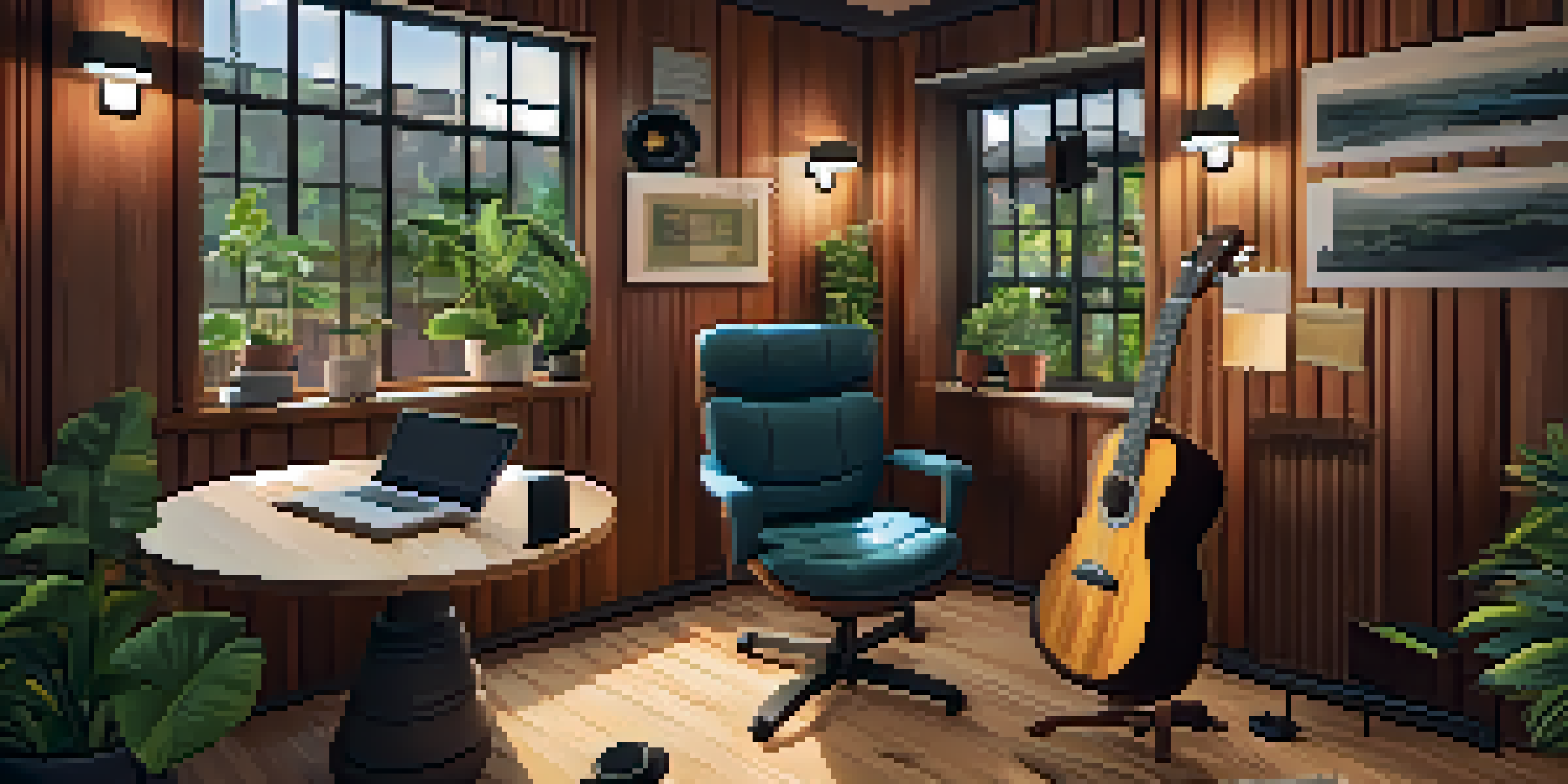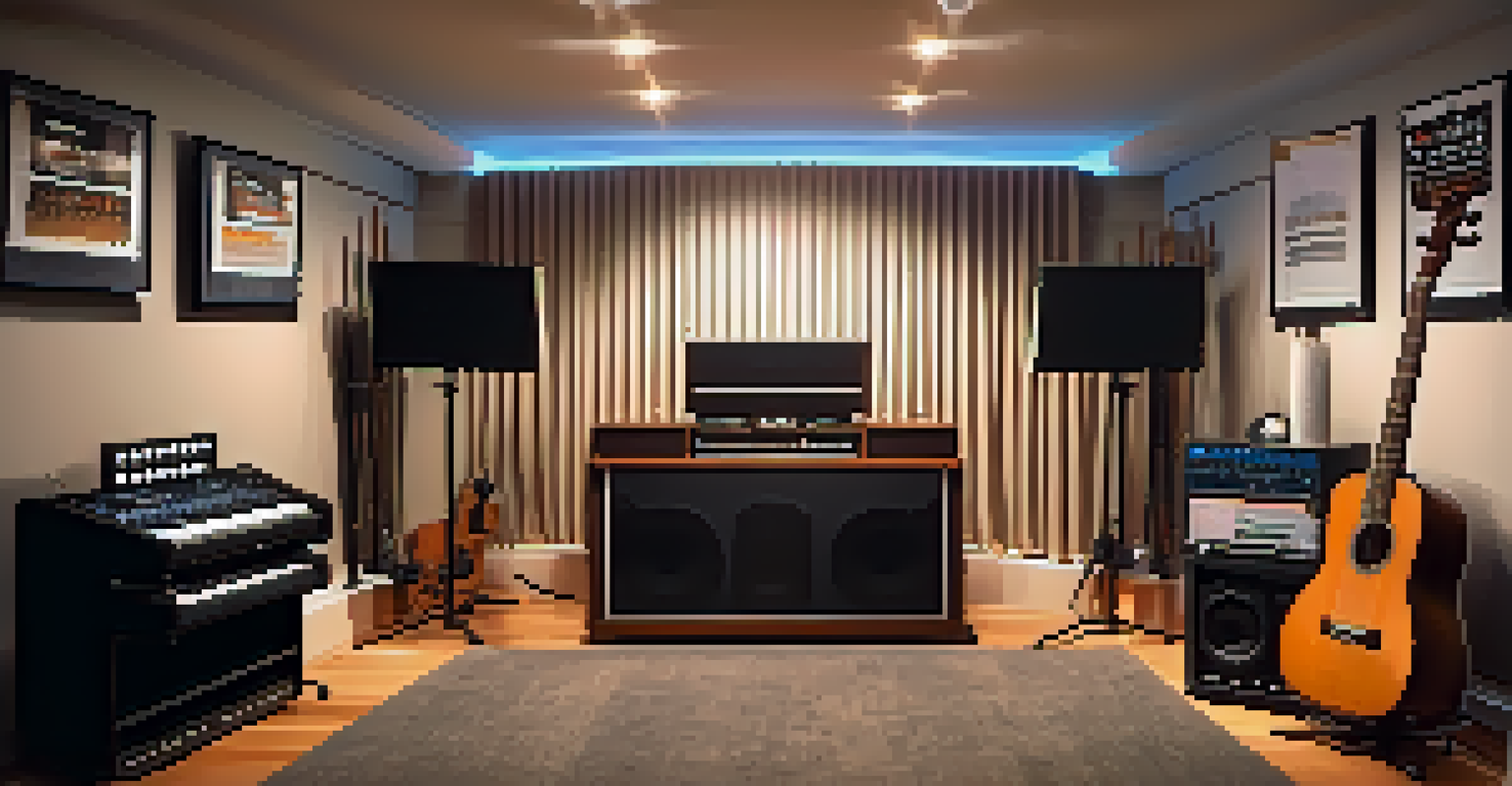Acoustic Treatment Tips for Ukulele Recording Spaces

Understanding Acoustic Treatment Basics for Ukulele Spaces
Acoustic treatment is crucial for achieving high-quality recordings, especially when it comes to instruments like the ukulele. By controlling sound reflections, you can create a more balanced audio environment that enhances the ukulele's warm tones. Think of it as tuning your space just like you would tune your instrument for optimal performance.
Music is the shorthand of emotion.
The goal of acoustic treatment is to minimize unwanted echoes and reverb that can muddy your recordings. This means absorbing or diffusing sound waves to create a clearer and more focused sound. Just as you wouldn't want your ukulele to sound out of tune, you don't want your recording space to distort your music.
With a bit of planning and the right materials, you can transform any room into a ukulele-friendly recording environment. Whether you’re a beginner or a seasoned player, understanding the basics of acoustic treatment will help you create a space that not only sounds great but also inspires your musical creativity.
Choosing the Right Materials for Acoustic Treatment
When it comes to acoustic treatment, selecting the right materials is essential. Common options include foam panels, bass traps, and diffusers, each designed to address specific acoustic challenges. For instance, foam panels are excellent for absorbing high frequencies, while bass traps help manage low-end sounds that can make recordings feel heavy.

Think of acoustic treatment materials like the different strings on your ukulele. Each type serves a unique purpose, and when combined effectively, they create a harmonious sound. Investing in quality materials can significantly enhance your recording quality, allowing your ukulele's natural tone to shine.
Importance of Acoustic Treatment
Acoustic treatment enhances recording quality by controlling sound reflections, ensuring optimal performance for instruments like the ukulele.
Additionally, you don't have to break the bank. Many DIY solutions, such as using thick blankets or carpets, can work wonders in reducing sound reflections. By being creative with your choices, you can develop a treatment plan that fits both your budget and your acoustic needs.
Strategically Placing Acoustic Panels for Optimal Results
The placement of acoustic panels can make a world of difference in your recording space. A common practice is to position them at the first reflection points, which are the spots on the walls where sound waves bounce back toward the microphone. This technique helps to reduce echo and creates a more direct sound capture, much like focusing a camera lens for a clearer image.
The beautiful thing about learning is that no one can take it away from you.
To find these reflection points, have a friend move a mirror along the walls while you sit in the listening position. Wherever you see the microphone in the mirror, that's where a panel should ideally go. This simple trick can dramatically improve the clarity of your recordings, allowing your ukulele to take center stage.
In addition to the walls, consider treating the ceiling and floor if your space allows. Sound can bounce from these surfaces too, so strategic placement will ensure a well-rounded treatment. Remember, the key is to create a balanced environment that supports the natural sound of your ukulele.
Incorporating Bass Traps for Low-End Control
Bass traps are essential in any recording space, especially if you're working with acoustic instruments like the ukulele. These specialized panels are designed to absorb low-frequency sounds, preventing them from overwhelming your recordings. Without proper bass control, your ukulele tracks can sound muddy and indistinct, much like trying to hear a whisper in a crowded room.
Place bass traps in the corners of your room, where low frequencies tend to accumulate. This strategic positioning will help balance the overall sound and ensure that the warmth of the ukulele is captured without excess boominess. Think of it as providing a solid foundation for your musical structure.
Material Choices Matter
Selecting the right materials, such as foam panels and bass traps, is essential for effectively managing different acoustic challenges.
While it might be tempting to skip bass traps, doing so can lead to frustrating recording sessions. By prioritizing low-end control, you’ll find that your ukulele recordings sound cleaner and more professional, allowing your creativity to flourish without distraction.
Using Diffusers for a Natural Soundscape
Diffusers play a crucial role in creating a natural sound environment in your recording space. Unlike absorbers, which soak up sound, diffusers scatter sound waves, preventing them from creating harsh echoes. This technique helps maintain a lively atmosphere while still keeping your recordings clear and focused, much like a well-balanced meal that satisfies but doesn't overwhelm your palate.
Placing diffusers on the back wall or high up on the sides can help create a more open sound. They allow the natural resonance of the ukulele to shine without letting undesirable reflections take over. It’s like allowing the sunlight into a room while filtering out the glare.
By incorporating diffusers into your acoustic treatment plan, you strike a harmonious balance between absorption and reflection. This thoughtful approach will enhance your recordings, making them vibrant and engaging, just like the music you create.
Creating a Dedicated Recording Area for Focused Sessions
Having a dedicated recording area can significantly improve your ukulele sessions. This space should be free from distractions and set up specifically for capturing sound. Just like a painter needs a clean canvas, a musician benefits from an organized environment tailored for creativity.
Consider using a smaller room with fewer windows and doors, which helps minimize external noise. You can enhance this space with your acoustic treatment choices, ensuring that every note played on your ukulele is recorded with clarity. A focused area allows you to immerse yourself in the music, leading to more authentic performances.
Testing for Optimal Sound
Regularly testing and adjusting your acoustic setup helps maintain a balanced and natural sound, improving the overall quality of your recordings.
To maximize your recording area, keep your equipment organized and easily accessible. This way, you can transition from practice to recording seamlessly, sparking inspiration without the hassle of setup. A dedicated space is not just a luxury; it’s an investment in your musical journey.
Testing and Adjusting Your Acoustic Treatment Setup
Once you’ve implemented your acoustic treatment, it’s important to test and adjust your setup. This process involves recording several snippets of your ukulele playing and critically listening to the playback. Just like tuning your instrument, tweaking your space will ensure that it’s performing at its best.
Take note of any areas where the sound feels off or where unwanted reflections occur. Adjust the placement of your panels, bass traps, and diffusers until you achieve a sound that feels balanced and natural. Remember, small changes can lead to significant improvements in your recordings.

This refining process is an ongoing journey, and it’s okay to make adjustments as you grow. Your recording space will evolve alongside your skills, enhancing the quality of your ukulele music. Embrace this dynamic process as part of your creative experience.